

| Visitors Now: | |
| Total Visits: | |
| Total Stories: |

| Story Views | |
| Now: | |
| Last Hour: | |
| Last 24 Hours: | |
| Total: | |
Chet Raymo, “Little Lesson, Part 1”
by Chet Raymo
“My colleague, theologian Greg Shaw, asked me the other day “Do scientists discover reality, or invent reality?” It is, of course, the ultimate question. Knowing Greg, I was sure he would come down on the invent side of the dichotomy. After a lifetime of reading and reflecting on the subject, I would imagine the answer lies somewhere between the poles, but leaning optimistically toward discover.
As a start, I offer Greg this poem of Wallace Stevens, called “Study of Two Pears.” Stevens wrestled long with the distinction between imagination and reality, as I have often discussed in this blog. In general, his poems are tricked out with the froufrou of invention. In “Study,” untypically, he strives for what might be called scientific objectivity:
Opusculum paedagogum.
The pears are not viols,
Nudes or bottles.
They resemble nothing else.
II
They are yellow forms
Composed of curves
Bulging toward the base.
They are touched red.
III
They are not flat surfaces
Having curved outlines.
They are round
Tapering toward the top.
IV
In the way they are modelled
There are bits of blue.
A hard dry leaf hangs
From the stem.
V
The yellow glistens.
It glistens with various yellows,
Citrons, oranges and greens
Flowering over the skin.
The shadows of the pears
Are blobs on the green cloth.
The pears are not seen
As the observer wills.
“I would translate that first line loosely as “a little lesson.” A little lesson on seeing and describing the world objectively, not “as the observer wills.” The poet’s usual métier is metaphor- pears as nudes, viols, or bottles, for example- but in this poem Stevens rejects that route. He strives to see the thing itself, unmediated by imagination. Does he succeed? Three metaphors. “Flowering.” And (arguably) “touched” and “modelled.” “Citron” and “orange” as color names, of course, already imply likenesses.
So let us admit at once that to describe reality at all we must use language that evolved out of the collective social, psychological and historical experience of our species. Language is an invention, even the mathematical language of the physicist. Reality, then, mediated by language, must necessarily be an invention. Or so it would seem. What then of discover? I’ll have more to say tomorrow, on behalf of discover, again with the help of the poet.”
2012-10-08 20:45:18
Source: http://coyoteprime-runningcauseicantfly.blogspot.com/2012/10/chet-raymo-little-lesson-part-1.html
Source:



